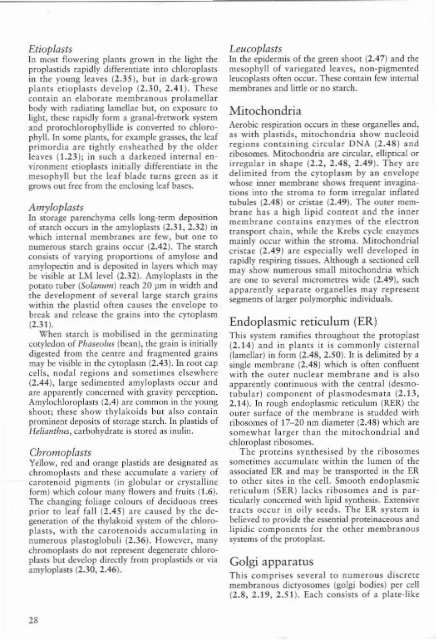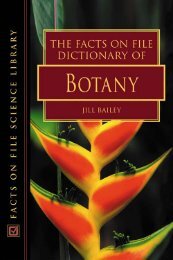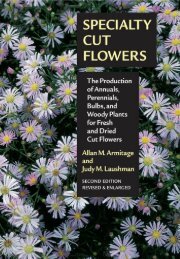Create successful ePaper yourself
Turn your PDF publications into a flip-book with our unique Google optimized e-Paper software.
Etioplasts<br />
In most flowering plants grown in the light the<br />
proplasrids rapidly differentiate into chloroplasts<br />
in the young leaves {2.35}, but in dark-grown<br />
plants erioplasrs develop (2.30, 2.41). These<br />
contain an elaborate membranous prolamellar<br />
body with radiating lamellae but, on exposure to<br />
light, these rapidly form a granaI-fretwork system<br />
and prorochlorophyllide is convened to chlorophyll.<br />
In some planes, for example grasses, the leaf<br />
primordia are righdy ensheathed by the older<br />
leaves (1.23); in such a darkened imernal en<br />
\'ironmem erioplasrs initially differentiate in the<br />
mesophyll but the leaf blade rums green as it<br />
grows out free from the enclosing leaf bases.<br />
Amyloplasts<br />
In storage parenchyma cells long-term deposition<br />
of starch occurs in the amyloplasts (2.31, 2.32) in<br />
which internal membranes are few, but one to<br />
numerous starch grains occur (2.42). The starch<br />
consists of varying proportions of amylose and<br />
amylopectin and is deposited in layers which may<br />
be visible at LM level (2.32). Amyloplasrs in me<br />
potato tuber (Solammt) reach 20 pm in width and<br />
the development of several large starch grains<br />
within rhe plastid often causes the envelope to<br />
break and release the grains into the cytoplasm<br />
(2.31).<br />
When starch is mobilised in the germinating<br />
cotyledon of Phaseoltts (bean), the grain is initially<br />
digested from the ceorre and fragmented grains<br />
may be visible in the cytoplasm (2.43). In root cap<br />
cells, nodal regions and sometimes elsewhere<br />
(2.44), large sedimenred amyloplasts occur and<br />
are apparently concerned with gravity perception.<br />
Amylochloroplasts (2.4) are common in the young<br />
shoot; these show thylakoids but also contain<br />
prominent deposits of storage starch. In plastids of<br />
Heliantlms, carbohydrate is stored as inulin.<br />
Chromoplasts<br />
Yellow, red and orange plastids are designated as<br />
chromoplasrs and these accumulate a variety of<br />
carotenoid pigments (in globular or crystalline<br />
form) which colour many flowers and fruits (1.6).<br />
The changing foliage colours of deciduous trees<br />
prior to leaf faJl (2.45) arc caused by the degeneration<br />
of the thylakoid system of the chloroplasts,<br />
with the carotenoids accumulating in<br />
numerous plastoglobuli (2.36). However, many<br />
chromoplasts do not represenr degenerate chloroplasts<br />
but develop directly from proplastids or via<br />
amyloplasts (2.30, 2.46).<br />
28<br />
Leucop/asts<br />
In the epidermis of the green shoot (2.47) and the<br />
mesophyll of variegated leaves, non-pigmented<br />
leucoplasts often occur. These contain few internal<br />
membranes and linle or no starch.<br />
Mitochondria<br />
Aerobic respiration occurs in these organelles and,<br />
as with plastids, mitochondria show nucleoid<br />
regions containing circular DNA (2.48) and<br />
ribosomes. Mitochondtia are circular, elliptical or<br />
irregular in shape (2.2, 2.48, 2.49). They are<br />
delimited from the cytoplasm by an envelope<br />
whose inner membrane shows frequenr invaginations<br />
into the stroma to form irregular inflated<br />
tubules (2.48) or cristae (2.49). The outer membrane<br />
has a high lipid contene and the inner<br />
membrane contains enzymes of the electron<br />
transport chain, while the Krebs cycle enzymes<br />
mainly occur within the stroma. Mitochondrial<br />
cristae (2.49) are especially well developed in<br />
rapidly respiring tissues. Although a sectioned cell<br />
may show numerous small mitochondria wrnch<br />
are one to several micrometres wide (2.49), such<br />
apparently separate organelles may represenr<br />
segments of larger polymorphic individuals.<br />
Endoplasmic rericulum (ER)<br />
This system ramifies Ihroughout the protoplast<br />
(2.14) and in plants it is commonly cisternal<br />
(lamellar) in form (2.48, 2.50). It is delimited by a<br />
single membrane (2.48) which is often confluent<br />
with the outer nuclear membrane and is also<br />
apparently continuous with the central (desmotubular)<br />
component of plasmodesmata (2.13,<br />
2.14). In rough endoplasmic reticulum (RER) the<br />
outer surface of the membrane is studded \vith<br />
ribosomes of '17-20 nm diameter (2.48) which are<br />
somewhat larger than the mitochondrial and<br />
chloroplast ribosomes.<br />
The proteins synthesised by the ribosomes<br />
sometimes accumulate within the lumen of the<br />
associated ER and may be transported in the ER<br />
to other sites in the cell. Smooth endoplasmic<br />
reticulum (SER) lacks ribosomes and is particularly<br />
concerned with lipid synthesis. Extensive<br />
tracts occur in oily seeds. The ER system is<br />
believed to provide the essenrial proteinaceous and<br />
lipidic components for the othet membranous<br />
systems of the protoplast.<br />
Goigi apparatus<br />
This comprises several 10 numerous discrete<br />
membranous dicryosomes (golgi bodies) per cell<br />
(2.8,2.19,2.51). E:1ch consists of a plate-like





